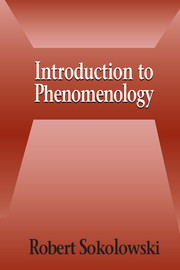Book contents
- Frontmatter
- Contents
- Acknowledgments
- Introduction
- 1 What Is Intentionality, and Why Is It Important?
- 2 Perception of a Cube as a Paradigm of Conscious Experience
- 3 Three Formal Structures in Phenomenology
- 4 An Initial Statement of What Phenomenology Is
- 5 Perception, Memory, and Imagination
- 6 Words, Pictures, and Symbols
- 7 Categorial Intentions and Objects
- 8 Phenomenology of the Self
- 9 Temporality
- 10 The Life World and Intersubjectivity
- 11 Reason, Truth, and Evidence
- 12 Eidetic Intuition
- 13 Phenomenology Defined
- 14 Phenomenology in the Present Historical Context
- Appendix: Phenomenology in the Last One Hundred Years
- Select Bibliography
- Index
6 - Words, Pictures, and Symbols
Published online by Cambridge University Press: 05 June 2012
- Frontmatter
- Contents
- Acknowledgments
- Introduction
- 1 What Is Intentionality, and Why Is It Important?
- 2 Perception of a Cube as a Paradigm of Conscious Experience
- 3 Three Formal Structures in Phenomenology
- 4 An Initial Statement of What Phenomenology Is
- 5 Perception, Memory, and Imagination
- 6 Words, Pictures, and Symbols
- 7 Categorial Intentions and Objects
- 8 Phenomenology of the Self
- 9 Temporality
- 10 The Life World and Intersubjectivity
- 11 Reason, Truth, and Evidence
- 12 Eidetic Intuition
- 13 Phenomenology Defined
- 14 Phenomenology in the Present Historical Context
- Appendix: Phenomenology in the Last One Hundred Years
- Select Bibliography
- Index
Summary
We have considered perception and its variants, but all the variants we have examined belong to our “internal” life: memory, imagination, and anticipation. This internal reenactment of our experiences is not the only domain in which changes in intentionality occur. Perception puts us in touch with things in the world, and variations can take place in how we directly interpret the objects that the world offers us.
Sometimes we just accept the object that is given to us (a tree, a cat). We are then engaged in simple perception. But sometimes we modify the way we take the thing being presented: we have some sounds or marks given to us, but we take them not just as sounds or marks, but as words; we have a panel of wood given to us, and we take it as a picture; we have a small pile of stones given to us, and we take it as a trail marker. In these cases we add to and hence modify the perception that remains as the base for such intentionalities. We introduce new intentionalities founded upon perceptions. We continue to perceive the marks, the wood, and the stones, but besides just perceiving them we intend them in a new way. These higher intentionalities, of course, are quite different from those at work in memory, imagination, and anticipation, which are internal reenactments of perception, not intentions built upon it.
- Type
- Chapter
- Information
- Introduction to Phenomenology , pp. 77 - 87Publisher: Cambridge University PressPrint publication year: 1999
- 1
- Cited by



